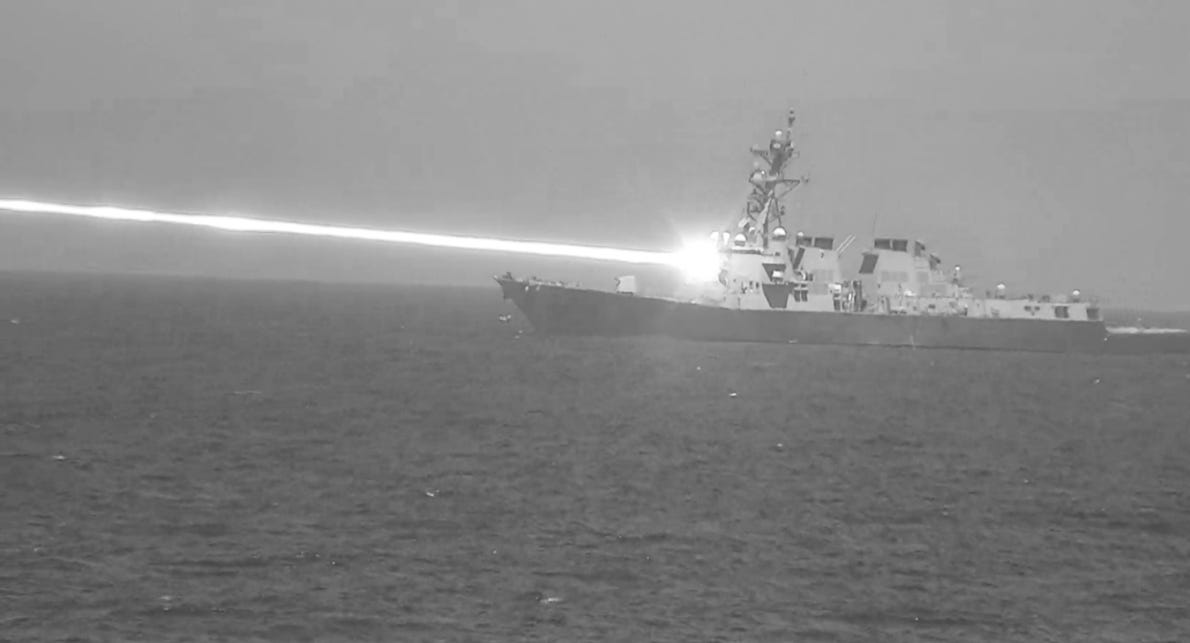Here's Your First Look at the Navy’s HELIOS Laser Weapon in Action
The Defense Department released a photo of the Navy's High Energy Laser with Integrated Optical Dazzler and Surveillance (HELIOS) system engaging a drone during testing.

The Defense Department just gave the world another glimpse at what the future of naval laser weapons might look like.
As part of an annual report from the Pentagon’s Director, Operational Test & Evaluation (DOT&E) released on January 31 summarizing weapons testing activities carried out during fiscal year 2024, the US military published a new photo of the US Navy’s High Energy Laser with Integrated Optical Dazzler and Surveillance (HELIOS) laser weapon system engaging an unidentified airborne drone target from aboard the Arleigh Burke-class destroyer USS Preble during testing under the auspices of the DOT&E’s Center for Countermeasures (CCM).
The CCM “supported the Navy’s demonstration on USS Preble (DDG 88) to verify and validate the functionality, performance, and capability of the [HELIOS] system against an unmanned aerial vehicle target,” the report says. “CCM collected imagery of the engagements to support the evaluation of system performance.”
It’s unclear when and where exactly the Navy conducted this test, other than that it occurred sometime during fiscal year 2024. The Preble subsequently departed its homeport of Naval Base San Diego in California in September of last year and joined Destroyer Squadron 15 at its forward-deployed location of Yokosuka, Japan the following October.
The new photo is the first known image of the Navy’s HELIOS laser weapon in action. It also represents the Navy’s first publicly-released image of a shipboard laser weapon in operation since December 2021, when the service published photos of the amphibious transport dock USS Portland’s 150 kilowatt Solid State Laser - Technology Maturation Laser Weapons System Demonstrator (LWSD) Mark 2 MOD 0 engaging a “static surface training target” in the Gulf of Aden.

The Navy had also previously released video of the Portland successfully disabling a drone with its LWSD in May 2020.
A combination 60 kW high-energy laser and optical dazzler system designed to counter airborne drones and small watercraft and disrupt adversary intelligence, surveillance, and reconnaissance sensors, the HELIOS was developed based on capabilities advanced through both the LWSD and the AN/SEQ-3 Laser Weapon System (LaWS), the latter of which famously adorned the bow of the amphibious transport dock USS Ponce back in 2014 before that vessel was decommissioned three years later.
The Preble is currently the only warship in the Navy surface fleet outfitted with the HELIOS, which was installed aboard the destroyer in 2022. According to federal contacting data analyzed by defense market intelligence group Obviant, the service awarded a contract with a $1.1 billion ceiling to Lockheed Martin back in 2018 deliver at least two HELIOS test units to the service (one for installation on an Arleigh Burke-class destroyer and another for ground testing) with an option of delivering an additional 12 production units through 2027.
Apart from the HELIOS, the Navy currently has eight Optical Dazzling Interdictor (ODIN) laser dazzlers installed aboard Arleigh Burke-class destroyers, according to a December 2024 update from the Congressional Research Service on the sea service’s shipboard laser efforts. Meanwhile, the service is aggressively pursuing its 300 kW High Energy Laser Counter ASCM Project (HELCAP) effort to tackle underlying technical challenges to shipboard laser weapons like beam control and atmospheric turbulence in pursuit of a system mature enough to counter incoming cruise missiles.
Based on comments from Navy officials, these laser weapons can’t show up abroad more warships soon enough amid the rising threat of hostile drones to US forces deployed around the world. Speaking to reporters at the Surface Navy Association’s (SNA) annual symposium this past January, US Fleet Forces Command boss Adm. Daryl Caudle stated that the service’s inability to scale up laser weapon systems across the surface fleet was straight-up “embarrassing.”
“There’s been many a thesis and dissertation written on building lasers on ships, but we’ve not transitioned that into a place where that’s an acceptable way to actually take out missile systems,” Caudle said, per Breaking Defense. “These things are based on renewable energy, so I can recharge the system … I don’t have to worry about payload [or] volume with directed energy. All those things are appealing to a navy, [but] we just haven’t really matriculated that into a place … that’s ready for prime time.”
Caudle’s comments underscoring the urgency of fielding shipboard laser weapons echo those made by Navy surface warfare chief Vice Adm. Brendan McLane at the previous year’s SNA symposium amid a flurry of drone and missile attacks in the Red Sea from Iran-backed Houthi militants in Yemen in response to Israel’s ongoing military campaign against Hamas in Gaza.
“What we’re facing in the Red Sea is more than just drones. We’re looking at land-attack cruise missiles, we’re looking at anti-ship ballistic missiles that are getting shot in the Red Sea by the Houthis. And our ships are dealing with all of those,” McLane said at the time, per DefenseScoop. “One of the things that I think we really need to get after quicker is we need to accelerate the development of directed energy weapons, whether it’s a laser, whether it’s a microwave.”
“I am not content with the pace of directed energy weapons,” he added. “We must deliver on this promise that this technology gives us.”
For more on the Navy’s shipboard laser weapons effort, read the Congressional Research Service’s latest brief on the subject here.



